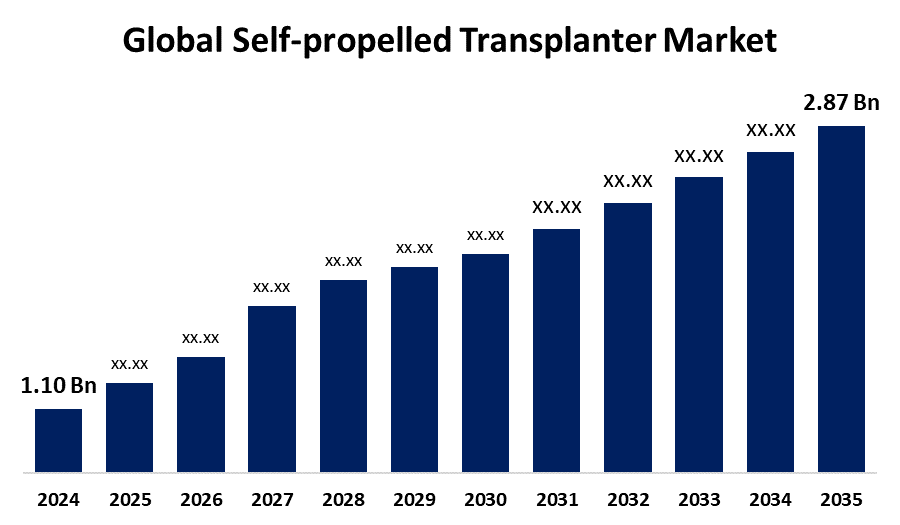Global Self-propelled Transplanter Market Size To Exceed USD 2.87 Billion By 2035 | CAGR Of 9.11%
Category: AgricultureGlobal Self-propelled Transplanter Market Size To Exceed USD 2.87 Billion By 2035
According to a research report published by Spherical Insights and Consulting, The Global Self-propelled Transplanter Market Size is Expected to Grow from USD 1.10 Billion in 2024 to USD 2.87 Billion by 2035, at a CAGR of 9.11% during the forecast period 2025-2035.

Get more details on this report -
Browse key industry insights spread across 234 pages with 103 Market data tables and figures & charts from the report on the “Global Self-propelled Transplanter Market Size, Share, and COVID-19 Impact Analysis, By Type (Mechanical Transplanters, Hydraulic Transplanters, Pneumatic Transplanters, and Electric Transplanters), By Crop Type (Vegetable Transplanters, Fruit Transplanters, Cereal Crop Transplanters and Flower Transplanters), By Application (Agricultural Fields, Commercial Nurseries and Greenhouses), and By Region (North America, Europe, Asia-Pacific, Latin America, Middle East, and Africa), Analysis and Forecast 2025 – 2035.” Get Detailed Report Description Here: https://www.sphericalinsights.com/reports/self-propelled-transplanter-market
The self-propelled transplanter industry is the business and commercial environment engaged in the production, sale, and distribution of self-propelled transplanting machines utilized in agriculture. Agricultural labor shortages and increasing wages have compelled farmers to turn to mechanized means. Self-propelled transplanters minimize labor needs by automating the transplanting process and enabling more rapid and efficient planting. This change enables farmers to fulfill close planting schedules and lower reliance on seasonal workers, propelling robust market demand. Moreover, GPS, automation, and intelligent farming technology advancements enable transplanting accuracy and efficiency gains. Autonomously operated transplanters with these technologies maximize seedling positioning, minimize wastage, and increase yields. Increasing emphasis on precision agriculture across the globe speeds up adoption, fueling market growth for sophisticated transplanting machines. However, autonomous transplanters cost a lot more than manual or semi-automatic transplanters. For marginal and small farmers, particularly developing country farmers, the initial cost is a significant deterrent. Even with subsidies, farmers are reluctant to incur the expense of expensive machinery because they lack access to financing or have unclear revenue prospects, limiting broader market penetration.
The mechanical transplanter segment dominated the market in 2024 and is projected to grow at a substantial CAGR during the forecast period.
Based on the type, the self-propelled transplanter market is divided into mechanical transplanters, hydraulic transplanters, pneumatic transplanters, and electric transplanters. Among these, the mechanical transplanter segment dominated the market in 2024 and is projected to grow at a substantial CAGR during the forecast period. The growth is driven by mechanical transplanters are versatile and can be used with several crops such as rice, vegetables, and flowers. Their flexibility allows farmers to employ one machine to perform various transplanting operations during the year. This flexibility in accommodating different agricultural needs increases their worth and applicability, resulting in wider applications and greater market share as opposed to other more specific types of transplanters.
The vegetable transplanters segment accounted for the highest share in 2024 and is anticipated to grow at a significant CAGR during the forecast period.
Based on the crop type, the self-propelled transplanter market is divided into vegetable transplanters, fruit transplanters, cereal crop transplanters, and flower transplanters. Among these, the vegetable transplanters segment accounted for the highest share in 2024 and is anticipated to grow at a significant CAGR during the forecast period. The segmental growth is due to vegetable crops having a shorter duration of growth than cereals and fruits, necessitating several transplanting operations during the year. The frequency makes it impractical and cumbersome to use manual labor. Self-propelled transplanters allow for quicker, more consistent planting, adding to the efficiency and productivity. Their capacity for repetitive transplanting operations makes them a boon for vegetable farmers, contributing to extensive adoption.
The agricultural fields segment held a substantial share in 2024 and is expected to grow at a significant CAGR during the forecast period.
Based on the application, the self-propelled transplanter market is divided into agricultural fields, commercial nurseries, and greenhouses. Among these, the agricultural fields segment held a substantial share in 2024 and is expected to grow at a significant CAGR during the forecast period. The growth is attributed to agricultural fields often span large areas, particularly in rice and vegetable cultivation. Labor transplanting over such distances is ineffective. Self-propelled transplanters increase productivity by traveling large parcels fast and evenly, cutting planting time short. Their ability to manage large-scale operations makes them indispensable tools, with high adoption in open-field farming.
Asia Pacific is expected to hold the majority share of the global self-propelled transplanter market during the forecast period.

Get more details on this report -
Asia Pacific is expected to hold the majority share of the global self-propelled transplanter market during the forecast period. Asia-Pacific region boasts the world's most diverse rice-producing nations such as China, India, Indonesia, and Vietnam. Rice is an integral crop and a staple commodity in these nations, giving rise to a strong demand for effective planting technologies. The huge rice field areas need mechanized transplanting technologies to enhance yields and address food security requirements. Self-propelled transplanters offer the precision and high speed needed to handle extensive rice farming across the region.
North America is anticipated to grow at the fastest pace in the global self-propelled transplanter market during the forecast period. North American farmers now more routinely employ precision agriculture technology, including GPS- and automatic-powered equipment, to maximize crop production and resource efficiency. Self-propelled transplanters with sophisticated controls are well aligned with this movement, providing accurate seedling placement and effective field coverage. This integration maximizes productivity and minimizes waste, leading to quick adoption. The region's emphasis on technology-based farming practices propels market expansion for new transplanter models.
Europe is predicted to hold a significant share of the self-propelled transplanter market throughout the estimated period. Europe has a strong culture of mechanized agriculture, where large-scale use of advanced farm machinery improves productivity and efficiency. Farmers prefer to use self-propelled transplanters due to their precision planting, less human labor, and maximized field operations. Such a high-tech culture for mechanization coupled with continuous innovation enables Europe to hold a notable share in the market for self-propelled transplanters by fulfilling the demand for efficient and high-quality planting solutions.
Major vendors in the global self-propelled transplanter market are FALC, Greaves Cotton Limited, Honda Power Equipment, Kerala Agro Machinery, Kirloskar Oil Engines, Kranti Agro, KUBOTA Corporation, Mahindra & Mahindra, Minos Agricultural Machinery, REKHA AGRIPLAS LIMITED, Shrachi Agro, V.S.T Weeders Tractors, Vijayalaxmi Agro Tools, YANMAR, Others.
Key Target Audience
- Market Players
- Investors
- End-users
- Government Authorities
- Consulting and Research Firm
- Venture capitalists
- Value-Added Resellers (VARs)
Recent Development
- In June 2024, Mahindra & Mahindra Ltd.'s Farm Equipment Sector (FES) rolled out the Mahindra 6RO Paddy Walker Transplanter in Maharashtra. The new model joins the company's already available 4-row walk-behind (MP461) and ride-on (Planting Master Paddy 4RO) transplanters, further cementing Mahindra's leadership in rice mechanization.
- In March 2024, During the Punjab Agricultural University (PAU) Kisan Mela in Ludhiana, a breakthrough in agricultural technology was launched: the remote-controlled 2-wheel automated paddy transplanter. This innovation was created by PAU's Department of Farm Machinery and Power Engineering to improve the efficiency and convenience of paddy transplantation.
Market Segment
This study forecasts revenue at the global, regional, and country levels from 2020 to 2035. Spherical Insights has segmented the self-propelled transplanter market based on the below-mentioned segments:
Global Self-propelled Transplanter Market, By Type
- Mechanical Transplanters
- Hydraulic Transplanters
- Pneumatic Transplanters
- Electric Transplanters
Global Self-propelled Transplanter Market, By Crop Type
- Vegetable Transplanters
- Fruit Transplanters
- Cereal Crop Transplanters
- Flower Transplanters
Global Self-propelled Transplanter Market, By Application
- Agricultural Fields
- Commercial Nurseries
- Greenhouses
Global Self-propelled Transplanter Market, By Regional Analysis
- North America
- US
- Canada
- Mexico
- Europe
- Germany
- UK
- France
- Italy
- Spain
- Russia
- Rest of Europe
- Asia Pacific
- China
- Japan
- India
- South Korea
- Australia
- Rest of Asia Pacific
- South America
- Brazil
- Argentina
- Rest of South America
- Middle East & Africa
- UAE
- Saudi Arabia
- Qatar
- South Africa
- Rest of the Middle East & Africa
About the Spherical Insights & Consulting
Spherical Insights & Consulting is a market research and consulting firm which provides actionable market research study, quantitative forecasting and trends analysis provides forward-looking insight especially designed for decision makers and aids ROI.
Which is catering to different industry such as financial sectors, industrial sectors, government organizations, universities, non-profits and corporations. The company's mission is to work with businesses to achieve business objectives and maintain strategic improvements.
CONTACT US:
For More Information on Your Target Market, Please Contact Us Below:
Phone: +1 303 800 4326 (the U.S.)
Phone: +91 90289 24100 (APAC)
Email: inquiry@sphericalinsights.com, sales@sphericalinsights.com
Contact Us: https://www.sphericalinsights.com/contact-us
Need help to buy this report?